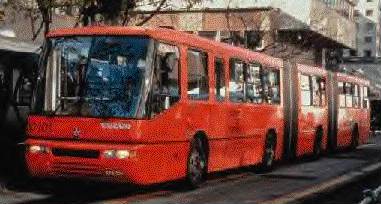
Light Rail Now/Light Rail Progress can be contacted at: Light Rail Now! |
Curitiba's "Bus Rapid Transit" – How Applicable to Los Angeles and Other U.S. Cities? Report by Darrell Clarke Note: The following analysis of the "Bus Rapid Transit" system in Curitiba, Brazil has been adapted from material on the Friends 4 Expo Transit website (formerly ExpoRail). Curitiba has, indeed, accomplished a lot on a limited budget. But what lessons from the Curitiba model are applicable to a city like Los Angeles? There are important details not covered in most articles on Curitiba. Curitiba is a compact city. Its five main radial bus lines are only about six miles long, with an average bi-articulated bus speed of just 12-13 mph (20 km/hr), too slow for longer trips. According to Volvo – manufacturer of some of these buses – "The average speed of the express buses is 32 km/h, and for the bi-articulated buses which stop every 500 metres, 20 km/h [12.4 mph]." A United States transit study group visited Curitiba in 1998. The following excerpts from their report summarize some of their findings: Prepayment of fares and level boarding, systems typically found in rail systems, create a very efficient boarding and deboarding process. A bi-articulated bus (a 5-door, 82-foot bus built by Volvo and currently used only in Curitiba) with a load of 270 people can board or deboard in about 20 seconds. The average speed of buses using the busway is 13 miles per hour--twice the estimated speed for buses operating in the same Curitiba corridors in mixed traffic. A Curitiba bi-articulated bus (twice the length of a standard 40-foot bus) seats only 57 – its "270 passengers" are mostly standing! This would hardly appeal to American riders, not to mention violating the Los Angeles MTA's consent decree with the Bus Riders Union to limit standees. By comparison, a new low-floor 40-foot bus seats about 38 people, 1/6 of a 3-car light rail train. Even Thomas Rubin, a zealous supporter of "Bus Rapid Transit" against virtually any rail alternative, raises questions about the applicability of Curitiba's operation to Southern California: First, it is somewhat questionable if large numbers of Southern California riders will accept the degree of overcrowding that we observed in Curitiba for long trips. More important, however, the Consent Decree in Labor/Community Strategy Center v. MTA requires MTA to operate buses with a peak load factor (the ratio of total passengers at the peak load point of each line to the number of seats on the bus) of no more than 1.2:1 by 2002. The Curitiba loads of 270 were achieved on buses with 57 seats, a load factor of 4.74. As for creating dedicated bus lanes along heavily traveled Wilshire Boulevard in Los Angeles, the idea of taking two existing traffic lanes plus its landscaped median for buses has so far received vocal opposition and little public support. Los Angeles Times columnist Robert Scheer recently made these observations about about Curitiba buses: Impressionable as I am, I bought into the new buses after watching a display put on by the by the governor of Curitiba's province. It all seems so cozily efficient, what with robot-like passengers being disgorged out of all the doors simultaneously, just like Disneyland.
But then Robson Ciro Chavez, a Brazilian living in the U.S., e-mailed me to set the record straight on mass transit in his hometown. I trust his summary that the system there, which we may copy, is one "where people wait, on rainy days, outside those tubes, and like cattle, [they] travel in crazy drivers' hands through the city." It appears Curitiba will be getting a rail system – the City of Curitiba's web site shows a monorail on a page (in Portuguese) of plans for a "Metro Elevado." While Curitiba has its fans, light rail's speed, comfort, and capacity have made it a popular success in the United States. Phoenix just voted to join the western cities of Portland, Seattle, San Francisco, Sacramento, San Diego, Los Angeles, Salt Lake City, Denver, Dallas, Houston, St. Louis, and Minneapolis, that all have or are building light rail. Darrell Clarke, a community leader in Los Angeles-area transit issues, founder of the Friends 4 Expo Transit, and a Santa Monica Planning Commissioner. For more information on "BRT", rail transit, and other public transport issues in the Los Angeles area, be sure to visit tne Friends 4 Expo Transit website at: Rev. 2005/03/28 | |
|
|
||